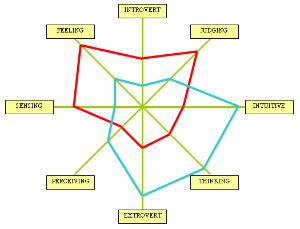Leadership - Style spider - choices
Style spider - choices
Choices
If you are putting together a team the style spider can be very useful.
Analyse existing and potential team members in the same way by giving values to each of the attributes as in the diagram.
Let us say that your style is the blue one and the red one belongs to another team member.
Ideally, you want team members to fill the gaps of your weaknesses. So if you feel that you are too ‘intuitive’ and you wish to have a balance in the team with a person who is more ‘sensing’ this person should fit well. The same applies with a balance of your ‘thinking’ style with someone who is more ‘feeling’ as in the diagram. You can do this with all of your strengths and weaknesses.
It is a weakness of leadership to surround yourself with too many like minded people as there will be inevitable clashes in particular areas.
Two extroverts will be vying for attention and recognition whilst two introverts may have great thoughtful ideas but may not be able to bring them to the attention of the group.
It is another tool in your armoury that will improve choice and maintain a balance.
Traits
The style spiders used here are based upon the Myers-Briggs Type Indicator® attributes or traits.
There is nothing stopping you developing other style spiders based upon other traits that you feel are more relevant for the tasks in hand.
You may think that these would be useful.
- Receptive and assertive
- Sensitive and insensitive
- Materialistic and social
- Blue sky and practical
- Global view and detail
- Risk taker and risk avoider
- Sharp and sluggish etc.
You can design your own and draw up the style spiders based upon what you are trying to achieve.
At the end of the day you are trying to influence a person in order to go one step nearer to achieving your vision.
To do this you must.
- Identify the style of the person.
- Examine your own style under the same traits.
- Analyse the overlaps and devise actions for best influence.
Influencing a person is a little more tricky in a meeting situation compared to a one-to-one.
In a meeting it is much easier to draw attention to all of the obstacles in the way of a proposal than to champion the good points.
No one would like a meeting to just highlight the good bits and ignore potential problems but there has to be a balance.
Once a person has shown his reticence for an idea in public he or she will find it more difficult to persuade them to accept the idea in private.
Very few proposals will be implemented with no hurdles or problems to solve.
You might wish to approach this problem by.
- Speaking to key people in private first to gauge their views and objections.
- Making sure you are aware of all the obstacles, risks and worries before a meeting so that you can prepare suitable answers ahead of time.
- This will allay fears and generate confidence in your proposal if you have clearly taken the time to consider the negative aspects.
You may be trying to influence your boss, or the next level up. Try not to please everybody as this is impossible to do and will lead to low performance.



